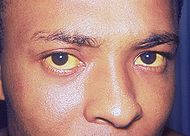Hepatitis implies injury to the liver characterized by the presence of inflammatory cells in the tissue of the organ. The name is from ancient Greek hepar, meaning liver, and suffix -itis, meaning "inflammation" .
The condition can be self-limiting, healing on its own, or can progress to scarring of the liver. A group of viruses known as the hepatitis viruses cause most cases of liver damage worldwide.
Hepatitis can also be due to toxins (notably alcohol) and other infections or from autoimmune process. It may run a subclinical course when the affected person may not feel ill. The patient becomes unwell and symptomatic when the disease impairs liver functions that include, among other things, removal of harmful substances, regulation of blood composition, and production of bile to help digestion.


